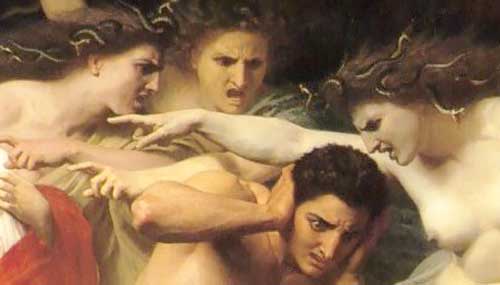.

In Greek mythology, the epithet Brimo (Βριμώ) "angry"[1] or "terrifying" may be applied to any of several goddesses with an inexorable, dreaded and vengeful aspect that is linked to the land of the Dead: to Hecate or Persephone,[2] to Demeter Erinyes— the angry, bereft Demeter—[3] or, perhaps, to Cybele[4]. Brimo is the "furious" aspect of the Furies. In the solemn moment when Medea picks the dire underworld root for Jason, she calls seven times upon Brimo, "she who haunts the night, the Nursing Mother [Kourotrophos]. In black weed And murky gloom she dwells, Queen of the Dead".[5]
The Thessalian or Thracian word Brimo was foreign in Attica.[6] Brimo-Hecate was worshipped at Pherae in Thessaly and has connections with Orphic religion, in which Persephone was prominent.[7]
The Alexandra of Lycophron makes clear that when Hecuba is to be transformed into one of the hounds of the triple Hecate, Brimo is an epithet of the Thessalian goddess of the Underworld.
Clement of Alexandria was of the opinion that Brimo was only a title of Demeter at Eleusis.[8] At the Eleusinian Mysteries, the Christian writer Hippolytus reports,[9] the hierophant announced the birth of Brimos: "The Mistress has given birth to a Holy Boy! Brimo has given birth to Brimos! that is, the Strong One to the Strong One"[10] Brimos is thus an epithet of Iacchos, the Holy Child of the virginal Persephone, whose epiphany was at the heart of the Eleusinian Mysteries.
In later, more worldly and cynical times, the archaic and fearful spirit could be mocked: in Lucian of Samosata's parody Oracle of the dead, Brimo is among the voters recorded by the magistrates of Hades: she groans her assent while Cerberus yelps "aye!".
In the Greek magical papyri found in Egypt, Brimo makes a natural appearance in incantations connected with the catabasis ritual, of entering the Underworld and returning unharmed.[11]
Notes
- ^ Obrimos, "raging" is an aspect of Ares (Harrison 1922:552.
- ^ Apollonius of Rhodes, Argonautica, iii.861 and 1211; John Tzetzes, Ad Lycophron 1211.
- ^ Arnobius, v.170.
- ^ Theodoret, Ther. i.699.
- ^ Harrison 1922:552. The translation is Miss Harrison's; the scholiast on the passage identifies Brimo as Hecate: "they called her Brimo because of the terror and horror of her."
- ^ Kerenyi 1967:92.
- ^ R. E. Glanville Downey, "The "Pure" Meadow" Classical Philology 26.1 (January 1931, pp. 94-97), p 95.
- ^ Clement, Protrepticus i.15.
- ^ Hippolytus of Rome, Philosophoumena v.1
- ^ Potnia kouron Brimou Brimon. See Jane Ellen Harrison, Prolegomena to the Study of Greek Religion, 3rd ed. 1922:551ff; Karl Kerenyi, Eleusis: Archetypal Image of Mother and Dughter 1967:92f.
- ^ Hans Dieter Betz, "Fragments from a Catabasis Ritual in a Greek Magical Papyrus" History of Religions 9.4 (May 1980), pp. 287-295.
References
- Smith, Dictionary of Greek and Roman Biography and Mythology
- Kerenyi, Karl, Eleusis: Archetypal Image of Mother and Child (Princeton: Bollingen Press) 1967.
See also : Greek Mythology. Paintings, Drawings
| Ancient Greece
Science, Technology , Medicine , Warfare, , Biographies , Life , Cities/Places/Maps , Arts , Literature , Philosophy ,Olympics, Mythology , History , Images Medieval Greece / Byzantine Empire Science, Technology, Arts, , Warfare , Literature, Biographies, Icons, History Modern Greece Cities, Islands, Regions, Fauna/Flora ,Biographies , History , Warfare, Science/Technology, Literature, Music , Arts , Film/Actors , Sport , Fashion --- |
Retrieved from "http://en.wikipedia.org"
All text is available under the terms of the GNU Free Documentation License

